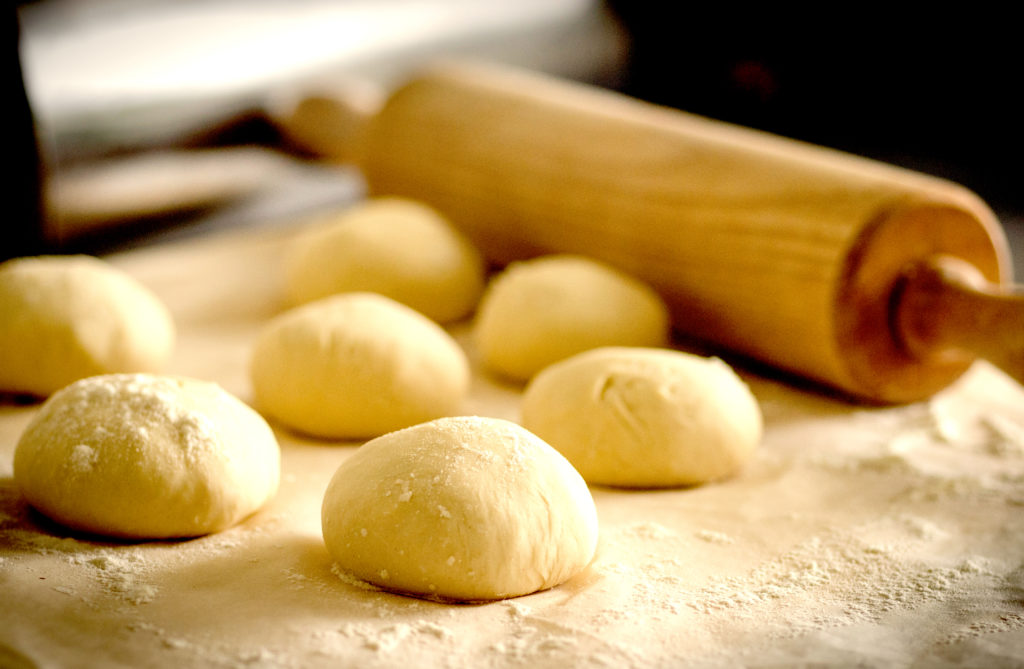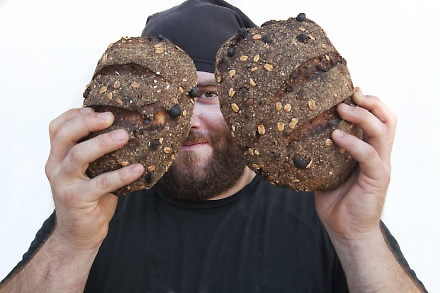[La Festa di San Giuseppe – March 19]
by Allison Scola
At this time of year, New Yorkers are starting to see a lot of green in honor of Saint Patrick’s Day. Yet in Sicily and southern Italy during these last days of winter, Sicilians and Italians are wearing a lot of red in honor of La Festa di San Giuseppe, or Saint Joseph’s Day, a Christian holiday that is celebrated annually on March 19.
Saint Joseph was the spouse of the Virgin Mary and the guardian-father of Jesus Christ. A carpenter by trade, he is regarded as the protector of all men who earn their livings through laborious work. He is also the patron saint of fathers. (March 19 is also Father’s Day in Italy.) Legend is that in Sicily and southern Italy during the 10th century, a drought caused a severe famine. The faithful prayed to Saint Joseph to bring rain, and in return, they promised to hold a feast in his honor. Rain and recovery from hunger did come, and since then, Saint Joseph has been one of the most venerated saints south of Rome.
It is no mistake that Saint Joseph’s Day coincides with the spring equinox and pre-Christian rituals that were celebrated to mark the end of winter. In the Northern Hemisphere, March marks a period of scarcity, when stored supplies are dwindling yet there are still some months before the Earth will yield a new crop. The festivities of Saint Joseph’s Day are linked to the land, vegetation, and the animal kingdom. It is a feast of thanksgiving for having survived through the winter months and a request for abundance in the spring and summer seasons ahead.
In Sicily and southern Italy, Saint Joseph’s Day is a communal holiday, and in many communities, especially small villages such as Salemi near Trapani, Valguarnera Caropepe near Enna, and Giurdignano near Lecce, starting days before the feast, they perform a series of rituals. For example, on the night of March 18, it is customary to light purifying bonfires where the faithful burn old and broken possessions they don’t want to carry into the new agricultural year. Most common on March 18 and 19, men of observing communities process a statue of Saint Joseph through village streets accompanied by the local marching band and needy children who are dressed up as angels and the Holy Family: Jesus, Mary, and Joseph.
The most notable and distinct ritual of Saint Joseph’s Day however, is the prepared altars or tables, known as le tavolate di San Giuseppe (or a Tavulatu di San Giuseppe in Sicilian). Customarily built by women as a prayer of thanks for the mercy and generosity the Saint has granted to their families and friends, the altars are an exhibition of abundance and a dialogue with God. They are a grand display of local specialties and sweets surrounded by citrus fruits, vegetables, wine, candles, pictures of the Saint and deceased loved ones, and plant elements such as nuts, seeds, beans, flowers, and laurel leaves. Most prominent, though, are the sculpted loaves of bread that represent fertility and prosperity.
Saint Joseph’s Day is primarily a celebration of bread, which in Sicily and southern Italy is sacred because wheat is the most important crop of the region. Bread-making is a devotional act that represents the presence of God and spiritual nourishment. It combines the fundamental elements of nature: earth, air, water, and fire. And Saint Joseph’s Day bread, most of which is not meant to be eaten, is artistically shaped as an act of prayer into wreaths, lilies, daisies, fava beans in their pods, fish, butterflies, doves, chalices, hearts, hands, and carpentry tools such as ladders, hammers, and pliers, and importantly, symbols of fatherhood, such as beards and flowering staffs.
The devotional tables are traditionally dressed with white clothes and branches of myrtle and laurel, which are agrarian symbols of good fortune. The tables are built with three tiers, recalling the holy trinity: the Father, the Son, and the Holy Spirit. They also don baskets in which the faithful place their prayer petitions for the year ahead.
After days, and sometimes weeks of preparation which often comes at a great monetary expense to the creator, a priest will come to the home or piazza where the altar was built in order to bless it. It is traditional to make as much food as one can afford with the aim of giving most of it away to the community—and specifically, to hungry and poor children of the village.
An essential element of the feast day’s activities is the tupa, tupa, or knock, knock ceremony. In a symbolic reenactment of Joseph seeking accommodation for his family the night of the birth of Christ, children dressed as the Holy Family knock on three homes’ doors—again recalling the holy number three. The first and second knocks are ceremoniously ignored or answered with, “There is no room for you here.” The knock on the third door is positively answered, and the three saints are joyfully invited to enjoy the bounty of the table.
The children, dressed as Jesus, Mary, and Joseph, are served a portion of all of the dishes prepared. Because the feast is during lent, the main dishes are meatless. Most Sicilian tables will include macco, a dried fava bean puree. Fava beans are recognized as having saved the population from hunger back in the 10th century because they were the one crop that thrived during the noted severe drought. Macco is eaten as a mash, spread on bread or as a soup, with or without pasta. Other dishes are made with wild fennel, artichokes, cauliflower, asparagus, or chickpeas. Most recipes include breadcrumbs, recalling the sawdust of Saint Joseph’s carpentry craft.
The highlight of the Saint Joseph’s Day feast however, is the sweet sfince di San Giuseppe. Sfinci are fried cream puffs served hot with a dusting of cinnamon, confectioner’s sugar, and honey or cold and open-faced with a smear of ricotta cream and decorated with candied orange. Depending on the town, sfinci may have a different appearance and different ingredients. In Naples, for example, they even have a different name: zeppoli. In Rome, they are called Bignè di San Giuseppe.
Once the saints have quietly and earnestly eaten, the hosting family and all their guests are invited to join the meal which is a communal and lively gathering of several families and a grand celebration of food.
Some historians believe that Saint Joseph is the Christianized representation of the ancient Greek and Roman mystery-cult figure Liber-Dionysus-Bacchus whose ancient, annual public rites were celebrated on March 17. Liber-Dionysus-Bacchus was the god of fertility, male virility, vegetation, ecstasy, and wine, hence his association with spring’s awakening and the beginning of a new agricultural cycle. Imagery of him includes a staff decorated with flowering vegetation—similar to popular images of Saint Joseph and the shape of many of the loaves of bread found on Saint Joseph’s feast day’s tables. Whatever the origins of Saint Joseph’s Day, the ritualistic activities used to celebrate it are a beautiful request for future abundance and wealth and a wonderful expression of thanksgiving and charity.
Main Sources
– Mariella Barbera and Irene Cavarretta, Architettura dei pani di Salemi. (Bagheria: Eugenio Maria Falcone Editore, 2012).
– Salvatore Farina, Sweet Sensations of Sicily. (Caltanissetta: Lussografica, 2009).
– Fabrizia Lanza, Coming Home to Sicily. (New York: Sterling Epicure, 2012).
– Pamela K. Quaggiotto, Altars of Food to Saint Joseph: Women’s Ritual in Sicily. (Columbia University, NY: Pamela K. Quaggiotto Ph.D. Thesis, 1988).
Click here to see an example of a St. Joseph’s Day altar.
Allison Scola is an independent scholar and professional musician and the owner and curator of Experience Sicily, an education and tourism company.
Click here to read more of Allison’s work on TIE: I Cannoli: Nothing Better in the World, and Genie in a Bottle: Colatura tradizionale di alci di Centara
 Tiziano Colibazzi is a poet in addition to being a psychiatrist and psychoanalyst. He is currently a first year MFA candidate for Poetry at the New School. Originally from Rome, Italy, Tiziano lives in NYC and he is the proud father of twin boys.
Tiziano Colibazzi is a poet in addition to being a psychiatrist and psychoanalyst. He is currently a first year MFA candidate for Poetry at the New School. Originally from Rome, Italy, Tiziano lives in NYC and he is the proud father of twin boys.


